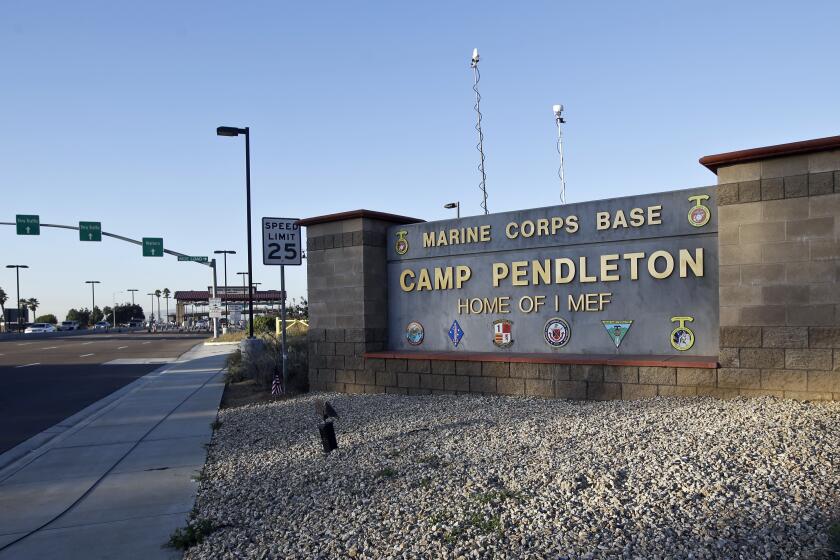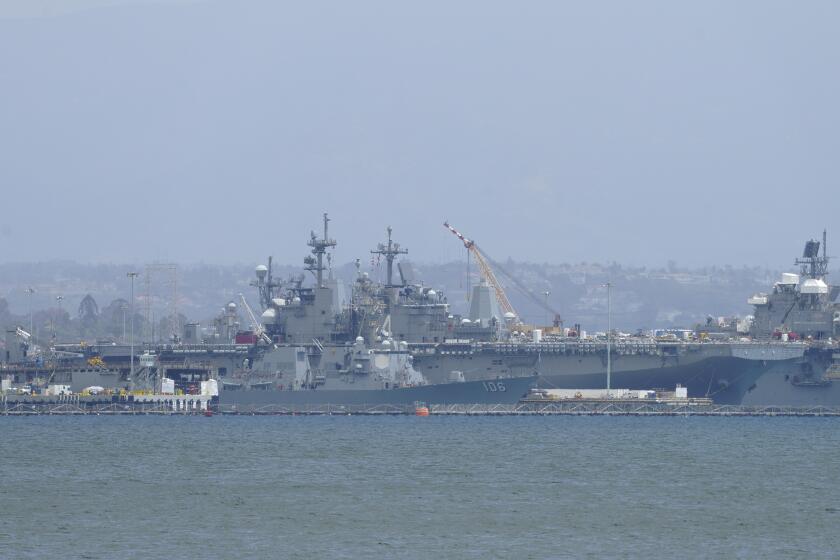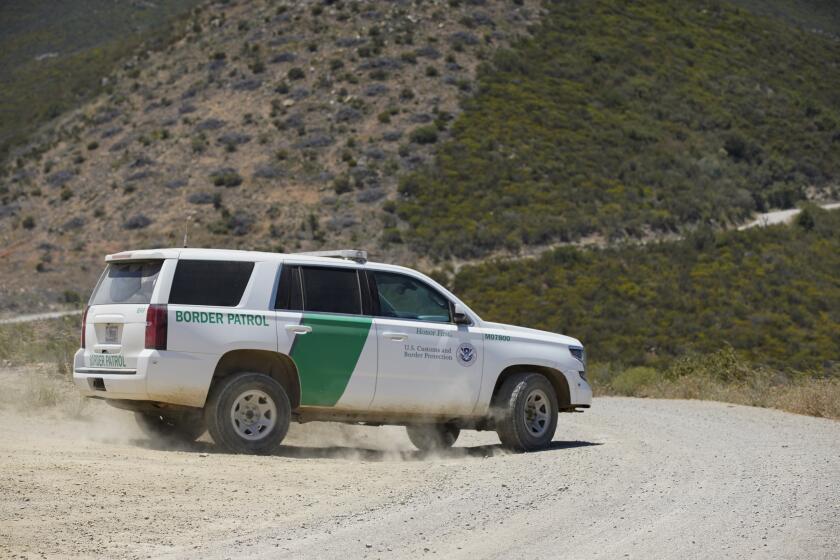Marines land ashore with Navy, Army
Marine tankers stormed the beaches at Camp Pendleton last week with an unusual mix of support, including ship crews from the Navy and Army.
The two-week, annual training exercise for the 4th Tank Battalion, which will end Monday, has focused this year on amphibious operations in San Diego County and integration between reserve and active-duty naval forces. The unit is comprised of mostly part-time troops assigned to companies in several states around the country, with active-duty command staff at Miramar Marine Corps Air Station.
For many of the reservists from Yakima, Wash., and other areas who camped in tents on Camp Pendleton’s White Beach, it was the first time they had trained on a ship from any service.
“These Marines are learning their trade as amphibious warriors,” said Lt. Col. Ronald Storer, inspector instructor for the battalion.
Capt. Ben Johanningsmeier, an operations officer, said: “We’ve been focusing on other priorities with the Iraqi and Afghanistan conflicts. We are finally getting back to our roots. … So while it’s old, it’s also new again.”
Nearly 500 troops participated, including personnel from San Diego-based assault craft and beach master units, as well as the Army’s 481st Transportation Company (Heavy Boat) out of Ventura County Naval Base — Port Hueneme.
The weight of the tanks is a major consideration in ship-to-shore delivery, along with the need to get close enough to avoid swamping the tanks.
Compared to wheeled vehicles like Humvees, “they’re a lot heavier, so there’s a lot more planning that goes into load plans with each type of craft,” said Navy Lt. Paul Sullivan of Naval Beach Group 1 based in Coronado. Its subordinate units include the landing craft, air cushion and beach master crews that usually transport Marine vehicles and “proof the lane” of approach to shore.
Only one 70-ton tank at a time could be transported aboard those Navy vessels during the training at White Beach.
Army Landing Craft Utility 2033 could carry five tanks at a time, providing an obvious tactical advantage: “They can amass more force on one amphibious landing,” said Army Chief Warrant Officer 4 Stephen Caragnola, the ship’s skipper under training.
His crew members had intended to load the tanks from sea. After one of the ship’s propellers busted early on, they continued the tank training in the protected waters of the Camp Pendleton boat basin.
The M1A1 Abrams main battle tanks crushed beach pebbles as they rolled toward the ship. For the Marine on shore and the Marine on deck guiding each $2 million vehicle onto the Army ship using hand signals, there was one major concern: “avoiding hitting anything on the ship! Keep it straight,” said Lance Cpl. William Nicewonger, 20, from Bonney Lake, Wash.
Each tank barely cleared the sides of the ship before it clanked onto deck.
On the way out, the turret end splashed into the blue-green water and exhaust rippled the air.
“I like it!” Johanningsmeier said, watching from shore.
The tanks, fitted with tall stovepipes for the engine intake and exhaust, can be submerged in up to 6 feet of water.
For the crew inside, a brief dip underwater while it climbed the steep ship ramp was a tense moment. When water covered the scopes, “it was a little rush. You went in, it went black for a little while and then you just popped up. It was kind of fun,” said one driver, Pfc. Michael Etherton, 20, of Kenniwick, Wash. The tricky part, he added, was “making sure I hit the throttle at the right time so it didn’t stop the tank while I was in the water.”
An Army ship at a Marine base is an unusual sight. But Caragnola, a reservist from Maui, is used to head-scratching.
“People are still surprised the Army has vessels. During Vietnam, it was very common. Now they’ve shrunk the fleet down so much you just don’t see it. It’s a very small community.”
Usually, his ship transports logistics materials between merchant marine vessels at sea and floating docks or a portable steel pier. To stay relevant, the mission is changing from logistics support toward maneuver support for ground troops, including increasing business with three-letter government agencies and Navy SEALs, Caragnola said.
For the blue-green, Navy-Marine Corps team, tanks on ships is old hat. Tanks are deployed in the Atlantic and Pacific Oceans every day with Marine expeditionary units aboard Navy amphibious assault ships. Airlifts onto beachheads are less common.
“Tanks coming ashore by ships is how we get to where we’re going. …- And tanks are a critical piece as we deal with crisis response and any crisis escalates,” said Storer, the inspector instructor.
Tank-on-tank battles between nation states are the most common use for the vehicles, which provide expeditionary armor-protected firepower, a shock effect and support for maneuver forces. They also are useful for breaching enemy lines, for instance during the 2003 march to Baghdad during the Iraq invasion.
The tank’s surveillance and mobile communications capabilities also can help commanders control the battlefield in support of infantryman on foot, as Marine tankers did in Helmand province, Afghanistan in recent years.
“The tank’s thermal optics on the vehicle actually give it a very safe platform to conduct that type of surveillance in a counterinsurgency environment,” Storer said.
In addition to the shore landings, the 4th Tanks practiced what happens next during live fire exercises with infantrymen from Kilo Company, 3rd Battalion, 1st Marine Regiment.
On base at San Mateo canyon, infantrymen dropped off by the 4th and 3rd Assault Amphibian battalions followed the tanks as they set up a support by fire position. Then the tanks covered the infantry as they fought toward their objective.
“We have to be able to train to that. Otherwise, when you actually get into a combat environment, that infantry will not know how to employ the tank and the tank will be either left exposed or under-utilized,” Johanningsmeier said.
Get Essential San Diego, weekday mornings
Get top headlines from the Union-Tribune in your inbox weekday mornings, including top news, local, sports, business, entertainment and opinion.
You may occasionally receive promotional content from the San Diego Union-Tribune.





